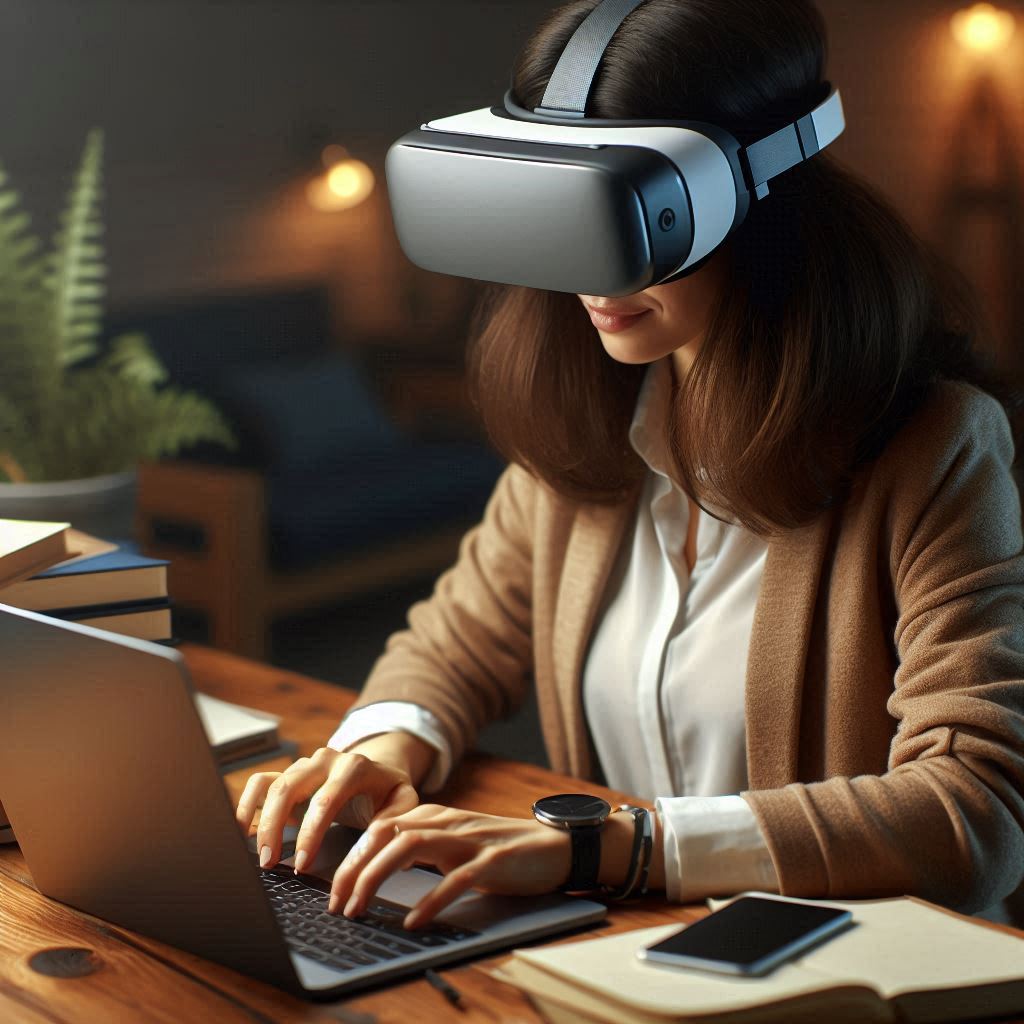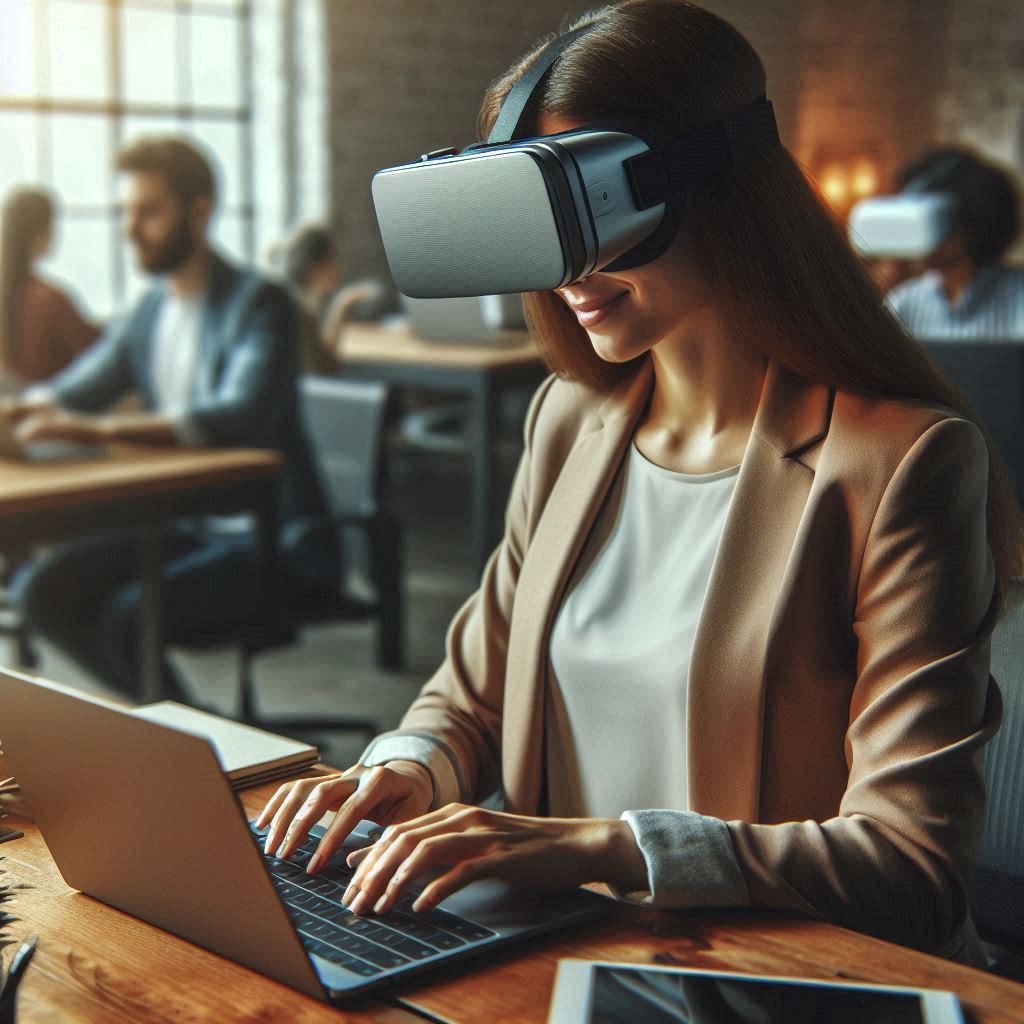Introduction
lets explore virtual reality classrooms: the future of interactive distance learning
Overview of the evolution of distance learning
Distance learning has rapidly evolved over the past few decades.
Starting with correspondence courses, it quickly adapted to online platforms.
The advent of the internet revolutionized access to education.
Students now engage in virtual classes from anywhere in the world.
This shift set the stage for further technological advancements.
virtual reality (VR) as an emerging technology
One such advancement is virtual reality (VR).
This emerging technology immerses users in interactive, three-dimensional environments.
VR has made significant strides in gaming and entertainment industries.
However, its potential in educational settings remains largely untapped.
Educators and institutions are beginning to recognize VR’s unique features.
Importance of exploring the potential of VR in educational settings
Exploring VR in education is essential for several reasons.
First, it enhances student engagement through immersive experiences.
Unlike traditional learning, VR allows students to visualize complex concepts.
This makes learning interactive and enjoyable, fostering greater retention of information.
Furthermore, VR can simulate real-world scenarios in a controlled environment.
Second, VR provides opportunities for collaborative learning.
Students from different locations can interact and collaborate in virtual classrooms.
This destroys geographical barriers and fosters a sense of community.
They participate in group projects and discussions, enhancing their learning experience.
Such collaboration cultivates teamwork and communication skills, critical for the modern workplace.
Moreover, VR supports personalized learning experiences.
Each student can learn at their own pace and according to their unique needs.
Educators can customize lessons tailored to individual learning styles.
This flexibility leads to a deeper understanding of the material.
It allows students to explore subjects beyond traditional curriculum constraints.
Lastly, integrating VR into educational settings prepares students for the future.
As technology continues to evolve, proficiency in VR may become crucial.
Familiarity with such technologies will better equip students for the workforce.
Embracing VR holds the potential to revolutionize distance learning.
Therefore, further exploration and implementation of VR in education are vital.
Introduction to Virtual Reality in Education
Virtual reality (VR) represents an innovative approach to education.
It uses advanced technology to create immersive learning experiences.
With VR, learners can engage with their subjects in a whole new way.
This technology goes beyond traditional teaching methods, making learning more dynamic and interactive.
Put Your Tech Company on the Map!
Get featured on Nicholas Idoko’s Blog for just $50. Showcase your business, boost credibility, and reach a growing audience eager for tech solutions.
Publish NowDefinition of Virtual Reality
Virtual reality refers to a computer-generated environment.
This environment simulates real or imagined conditions.
Users interact with this space through specialized equipment.
Key components of virtual reality include:
- Hardware: This includes VR headsets, motion controllers, and sensory devices.
- Software: This includes applications and programs that create VR environments.
These components work together to deliver immersive experiences.
Users feel present in a digital world, enhancing their learning capabilities.
Immersive Learning Experiences
Immersive learning experiences facilitated by VR transform education.
Here’s how they work:
- Engagement: VR captures learners’ attention and holds it through interactive content.
- Interactivity: Learners can manipulate the virtual environment, promoting active participation.
- Realism: The lifelike simulations help learners understand complex concepts better.
- Safety: VR allows students to practice skills in a risk-free environment.
- Customization: Educators can tailor lessons to individual learning styles and needs.
These elements combine to create rich educational experiences.
Traditional learning methods often lack this level of engagement and interactivity.
VR bridges that gap, leading to deeper understanding and retention of information.
Current Applications of VR in Education
Increasingly, educators adopt VR in various educational settings.
Current applications of VR in education include:
- Medical Training: VR simulates surgeries and medical procedures, allowing students to practice without risks.
- Historical Reenactments: Students can witness historical events, enhancing their understanding of the past.
- Environmental Science: Learners can explore ecosystems, understanding biodiversity and conservation efforts.
- Language Learning: Immersive environments allow students to practice languages in context.
- Architecture and Design: Students can walk through virtual structures, visualizing their designs.
These applications highlight the versatility of VR in education.
They demonstrate how the technology can address various learning objectives.
As more institutions adopt VR, we will likely see even more innovative uses.
Benefits of Virtual Reality in Education
Integrating VR into education offers numerous benefits.
These advantages include:
- Enhanced Engagement: VR captures students’ interests and motivates them to learn.
- Improved Collaboration: VR promotes group work through shared virtual experiences.
- Accessibility: VR breaks geographical barriers, allowing remote learning opportunities.
- Personalized Learning: VR can cater to various learning paces and styles.
- Increased Retention: The immersive nature of VR enhances knowledge retention.
These benefits make VR an attractive option for educators.
The technology not only modernizes teaching but also enriches students’ experiences.
Challenges of Implementing Virtual Reality in Education
Despite its advantages, implementing VR in education presents challenges.
Understanding these challenges is essential for successful integration:
- Cost: High-quality VR equipment and software can be expensive.
- Technical Limitations: Not all schools have access to the necessary technology, affecting implementation.
- Training Requirements: Educators may need training to use VR tools effectively.
- Content Development: Creating effective VR content requires time and expertise.
- Student Distraction: Some students may become overly focused on the technology rather than learning.
Addressing these challenges is vital for maximizing VR’s potential in education.
Schools and institutions must assess their resources and readiness for technology integration.
The Future of Virtual Reality in Education
The future of VR in education looks promising.
As technology advances, its applications will become more sophisticated.
Possible developments include:
- More Affordable Equipment: Advances in technology may reduce costs for schools and institutions.
- Improved Software: Future applications will likely feature more interactive and engaging content.
- Integration with Other Technologies: VR may combine with augmented reality (AR) for enhanced learning experiences.
- Expanding Applications: New fields may adopt VR, broadening its use in education.
- Increased Research: Continued research will enhance our understanding of VR’s impact on learning.
As VR technology continues to evolve, it will profoundly shape education.
The possibilities for immersive learning are extensive, promising exciting futures for both educators and learners.
Virtual reality holds great potential for transforming education.
By creating immersive learning experiences, it redefines how students engage with content.
Despite challenges, the benefits of VR in education are clear.
As we embrace this technology, we open new doors for interactive distance learning.
Read: How Open-Source LMS is Revolutionizing University Education in 2024 & 2025
Advantages of VR Classrooms
As technology progresses, virtual reality (VR) emerges as a significant force in education.
Put Your Tech Company on the Map!
Get featured on Nicholas Idoko’s Blog for just $50. Showcase your business, boost credibility, and reach a growing audience eager for tech solutions.
Publish NowTraditional classrooms often struggle to engage students fully, but VR classrooms can transform how learners interact with content.
Students experience lessons in a dynamic environment that encourages exploration and creativity.
Enhanced Engagement through Immersive Experiences
One of the most notable advantages of VR classrooms is the increased engagement they offer.
Here’s how immersion enhances learning:
- Realistic Simulations: VR allows learners to participate in realistic environments. For instance, students can explore ancient civilizations or walk through the human body.
- Interactive Learning: These immersive experiences encourage active participation. Students can manipulate 3D objects, enhancing retention and comprehension.
- Gamification: VR can gamify lessons, making learning enjoyable. Students engage with educational content through challenges and rewards, boosting motivation.
- Multi-Sensory Experiences: VR stimulates multiple senses, helping students process information in unique ways. This leads to deeper understanding and retention of material.
In traditional classrooms, students often disengage, especially with lectures.
VR alleviates this issue, capturing their attention and making learning enjoyable.
Greater Accessibility for Remote Learners
VR classrooms break geographical barriers, providing opportunities for remote learners.
This accessibility presents several benefits:
- Global Reach: Students from anywhere in the world can access courses without traveling. This fosters a diverse learning environment.
- Flexible Learning Schedules: VR classrooms accommodate various schedules, allowing learners to study when it suits them best.
- Cost-Effectiveness: Eliminating commuting expenses makes education more affordable. Students save money on transportation and housing.
- Inclusivity: Students with disabilities can participate more easily. Virtual environments can adapt to specific needs.
By providing an inclusive and accessible platform, VR classrooms cater to diverse learners.
This flexibility ensures that students can pursue their educational goals without traditional barriers.
Opportunities for Experiential Learning in a Safe Environment
VR classrooms provide opportunities for experiential learning.
Students can explore complex concepts in a controlled setting.
Here’s why this is essential:
- Risk-Free Exploration: Students can experiment without real-world consequences. For example, they can practice surgical techniques on virtual patients.
- Hands-On Experience: VR simulates real-world scenarios that enhance learning. Students can engage in experiments, workshops, or complex simulations.
- Crisis Management: Students can participate in crisis scenarios, such as emergency response training. This prepares them for real-life situations.
- Skill Development: VR promotes the development of critical skills. Students enhance teamwork, problem-solving, and decision-making abilities.
These experiences are invaluable for professional training and skill development.
Students become more prepared for challenges in their respective fields.
Customizable Learning Experiences Catering to Different Learning Styles
All students learn differently, and VR classrooms recognize this fact.
This technology allows for customizable experiences tailored to individual learning preferences.
Here’s how:
- Audiovisual Learning: VR provides visual and auditory stimuli, appealing to visual and auditory learners. This approach aids in retaining information effectively.
- Kinesthetic Learning: Students engage physically with VR materials, making it ideal for kinesthetic learners. They can interact with objects and manipulate elements freely.
- Self-Paced Learning: VR classrooms allow students to progress at their own pace. This personalization ensures that every learner can master the content.
- Variety of Content: Educators can create diverse VR scenarios catering to various subjects and topics. Each experience can target different learning objectives.
Customizable learning experiences ensure that every student can thrive.
This flexibility enhances learning outcomes and empowers students to take control of their education.
In summary, VR classrooms revolutionize the educational landscape.
They provide immersive experiences, enhance accessibility, and foster experiential learning.
Additionally, they cater to individual learning preferences.
As the technology continues to evolve, schools and universities must explore VR as a viable teaching tool. Embracing this innovation will prepare students for the challenges of the future. Fearless learners are the key to advancing knowledge in the 21st century.
Read: Top Customizable E-Learning Platforms for Corporate Training in 2024 & 2025
Challenges and Limitations of VR in Distance Learning
While virtual reality (VR) classrooms offer exciting possibilities, several challenges exist.
These hurdles can impede the widespread adoption of VR in distance learning.
Let’s explore these challenges in detail.
High Costs of VR Equipment and Software
The financial investment for VR technology remains significant.
Schools and universities face high upfront costs for VR headsets and compatible hardware.
These costs often include:
- High-quality VR headsets, which can range from a few hundred to several thousand dollars.
- Powerful computers necessary to run VR environments smoothly.
- Specialized software that enables virtual classroom experiences.
Funding for these investments can be a barrier.
Many educational institutions operate under tight budgets.
Consequently, this limits their ability to implement VR.
Additionally, costs don’t end with initial investments.
Put Your Tech Company on the Map!
Get featured on Nicholas Idoko’s Blog for just $50. Showcase your business, boost credibility, and reach a growing audience eager for tech solutions.
Publish NowOngoing maintenance and software updates can further strain budgets.
Therefore, many institutions may hesitate to adopt VR technology.
Technical Barriers to Access for Some Students
Not all students have equal access to technology.
VR requires reliable internet connectivity and appropriate equipment.
Unfortunately, many students face disparities in access to these resources.
This digital divide can create inequities in learning opportunities.
Key technical barriers include:
- Insufficient internet speed, which can lead to lag and frustration during sessions.
- Lack of VR hardware, particularly in lower-income households.
- Potential motion sickness or discomfort that some users experience while using VR.
Students in rural or underserved areas may struggle to participate fully in VR activities.
This can lead to disconnection from their peers.
Furthermore, teachers may find it challenging to accommodate all students in a VR learning environment.
Need for Teacher Training in Effective VR Integration
Successful implementation of VR in education requires teacher training.
Instructors must understand VR tools and methods.
Additionally, they need to integrate these tools into their lessons effectively.
However, many teachers lack training in this area. Major training challenges include:
- Limited professional development opportunities focused on VR.
- Inadequate knowledge about best practices for using VR in the classroom.
- Difficulty in creating lesson plans that fully utilize VR’s potential.
Without proper training, teachers may struggle to engage students in VR environments.
This can lead to unsatisfactory learning experiences.
Furthermore, educators may not feel confident using VR technology, which can hinder its effectiveness in the classroom.
Concerns Over Content Development and Curriculum Alignment
Content development for VR applications presents significant challenges.
Effective educational content must be interactive and engaging.
Additionally, it should align with existing curricula.
However, several issues surround content development:
- The scarcity of high-quality, curriculum-aligned VR content.
- Content that may not meet the diverse needs of all students.
- The potential for VR content to become outdated quickly as technology evolves.
Educational institutions may struggle to find appropriate materials.
Furthermore, they may face difficulties customizing content to suit specific educational standards.
This lack of tailored resources can limit the effectiveness of VR integration in various subject areas.
Balancing VR Use with Traditional Learning Methods
As educators explore VR’s potential, they must strike a balance with traditional methods.
VR should complement, not replace, face-to-face interactions.
However, some educators may feel pressure to shift entirely to VR.
This can pose challenges such as:
- Difficulty determining when to use VR versus traditional teaching methods.
- Inconsistent engagement levels among students with different learning styles.
- Classroom management challenges in a virtual environment.
A balanced approach allows educators to harness both VR and traditional methods.
This flexibility can cater to a wider range of students.
Ultimately, instructors must continuously evaluate the effectiveness of both strategies.
Potential for Distraction and Overstimulation
VR experiences can sometimes be overwhelming for students.
High levels of interactivity may engage students but might also distract them.
The immersive nature of VR can lead to overstimulation.
Distraction can manifest in several ways:
Put Your Tech Company on the Map!
Get featured on Nicholas Idoko’s Blog for just $50. Showcase your business, boost credibility, and reach a growing audience eager for tech solutions.
Publish Now- Students may focus more on the technology than the educational content.
- Increased difficulty in maintaining attention during complex tasks.
- Challenges in transitioning back to traditional learning environments.
Creating a structured VR learning environment is crucial.
This helps maintain focus and encourages students to engage with the material.
Educators must monitor students’ experiences to prevent distractions.
Looking Ahead
Despite these challenges, VR holds significant potential for revolutionizing education.
Institutions can address these hurdles through strategic planning.
By investing in training, infrastructure, and content development, they can enhance the learning experience.
Collaboration among educators, administrators, and technologists can also drive progress in this exciting field.
Ultimately, the successful integration of VR in distance learning depends on overcoming these challenges.
This can lead to a more interactive and engaging educational landscape for all students.
Read: Best Interactive Software for Early Childhood STEM Learning in 2024 & 2025

Case Studies of VR Implementation in Education
The advent of virtual reality (VR) technology has sparked transformative changes in the field of education.
Numerous institutions globally have integrated VR into their distance learning programs, prompting enhanced engagement and improved learning outcomes.
This section explores exemplary cases of successful VR application in education, showcasing the significant benefits of immersive learning experiences.
Examples from Institutions Effectively Using VR for Distance Learning
Several educational institutions have effectively employed VR technology to enrich their curricula.
Here are some noteworthy examples:
- University of Southern California (USC): USC’s School of Cinematic Arts incorporates VR into storytelling courses.
Students experience immersive environments, facilitating an understanding of narrative techniques through practical application. - Stanford University: Stanford’s Virtual Human Interaction Lab offers students a chance to engage in empathetic learning. In one project, students experience social scenarios in VR, enhancing their understanding of diverse perspectives.
- Harvard University: Harvard Medical School uses VR for training future physicians. Through simulations, medical students practice surgical techniques and interact with virtual patients, boosting their practical skills.
- European University Cyprus: This institution integrates VR into its architecture program. Students can walk through virtual buildings, developing spatial awareness and practical design skills without the physical constraints of a classroom.
- Purdue University: Purdue employs VR to simulate laboratory experiences for engineering students. This hands-on approach helps maintain safety while encouraging experimentation and problem-solving.
Student Testimonials and Outcomes from VR-Enhanced Programs
The effectiveness of VR in education is not just theoretical; students have expressed profound effects on their learning experiences.
Here are some testimonials reflecting these outcomes:
- Enhanced Engagement: “Using VR immerses me in a different world that makes learning exciting and fun! It’s unlike anything I’ve experienced in traditional classes.”
- Improved Retention: “I remember the details of my VR lessons much better than those from my online courses. The experience is more vivid and engaging.”
- Increased Collaboration: “Working on group projects in VR allows us to interact in ways that video calls simply can’t. It feels more connected and interactive.”
- Broadened Horizons: “Traveling to ancient civilizations through VR broadens my understanding of history in a way that textbooks simply can’t.”
- Confidence Building: “Practicing surgery in a virtual environment prepares me for real-life scenarios, increasing my confidence and skills.”
Comparing Traditional Online Learning Experiences with VR-Based Learning
Traditional online learning often lacks the interactive elements that virtual reality (VR) provides.
Here are key differences between these approaches:
- Engagement: Online courses rely on videos and reading, while VR immerses students in dynamic environments.
- Interactivity: Online learning is passive, but VR enables active participation and hands-on experiences.
- Collaboration: VR fosters teamwork and a sense of presence, improving group collaboration over typical online discussions.
- Immersive Learning: VR captivates attention by allowing learners to explore concepts visually and experientially.
- Feedback: VR platforms deliver instant feedback through simulations, helping students immediately assess their understanding.
Studies show that VR significantly improves learning outcomes.
Research from the University of Maryland found that students using VR learned 60% faster than those in traditional online courses.
This suggests that VR can revolutionize distance education.
Additionally, VR enhances accessibility by allowing students from diverse backgrounds and locations to experience quality learning.
They can connect with peers and instructors worldwide, overcoming geographical limitations that traditional education often faces.
Institutions are beginning to integrate VR into their teaching.
As technology evolves, schools and universities will likely expand VR offerings, creating enriched curriculum experiences.
With investments in VR infrastructure and faculty training, students can expect more immersive learning opportunities.
VR not only engages learners but also deepens understanding and retention by bridging theoretical knowledge with practical application.
As case studies show, VR is transforming education and shaping the future of distance learning.
Read: How AI-Powered Software Transforms Professional Development Courses
Future Trends in VR and Distance Education
The future of Virtual Reality (VR) in education promises to reshape how students learn and interact.
As technology continues to evolve, several trends will dominate the landscape of distance education through VR.
Educators and institutions must stay informed about these developments to unleash the full potential of immersive learning environments.
Predictions for Technological Advancements in VR Tools
The next few years will witness remarkable advancements in VR tools that enhance learning.
Here are several key predictions:
Put Your Tech Company on the Map!
Get featured on Nicholas Idoko’s Blog for just $50. Showcase your business, boost credibility, and reach a growing audience eager for tech solutions.
Publish Now- Higher Resolution and Expanded Field of View: Future VR headsets will feature higher resolution displays, providing sharper images.
Increased field of view will create a more immersive experience, simulating a realistic environment for learners. - Wireless Capabilities: Upcoming VR devices will likely eliminate cables, offering greater freedom of movement.
Wireless technology will facilitate interaction and help students engage more fully with virtual environments. - Improved User Interfaces: The user experience for VR educational tools will become more intuitive. Enhanced interfaces will allow learners to navigate virtual spaces with ease, enabling efficient learning.
- Integration with Other Technologies: VR will increasingly integrate with Augmented Reality (AR) and Mixed Reality (MR).
Such integration will provide hybrid learning experiences, combining physical and virtual elements to enhance education. - Haptic Feedback Technology: New haptic devices will simulate touch, allowing learners to interact with virtual objects. This technology will enrich the learning experience by providing tactile feedback.
Expansion of VR Content Libraries and Platforms
As demand for VR in education grows, so will the content available for learners.
Several trends point towards the expansion of VR content libraries:
- Diverse Learning Materials: A broader range of subjects will see VR applications. From historical sites to scientific explorations, learning materials will be rich and varied.
- Collaboration with Content Creators: Educational institutions will partner with VR developers to create specific content.
These collaborations will ensure that the materials meet educational standards and effectively support learning objectives. - Open-Source Platforms: The emergence of open-source VR platforms will enable educators to develop and share their own content. This shift will foster innovation and creativity in educational experiences.
- User-Generated Content: Allowing learners and educators to create their own VR experiences will personalize learning. This approach will encourage engagement and enhance retention.
- Affordable VR Resources: As technology advances, VR tools will become more affordable. Increased accessibility will promote widespread adoption in various educational settings.
The Role of AI in Enhancing VR Learning Experiences
Artificial Intelligence (AI) will play a critical role in enhancing VR learning experiences.
Here’s how:
- Personalized Learning Pathways: AI will analyze learner behavior to create customized learning paths. This approach will help students progress at their own pace while receiving tailored feedback.
- Intelligent Tutoring Systems: AI-powered tutors will assist learners within VR environments. These systems will provide real-time support and explanations, thereby enhancing comprehension.
- Data-Driven Insights: AI will gather and analyze data from VR sessions. Educators will use these insights to improve course materials and teaching methods.
- Natural Language Processing: AI will enable learners to engage in conversational interactions within VR. Natural language processing will make these virtual environments more dynamic and responsive.
- Adaptive Learning Technologies: AI will adapt the difficulty of tasks based on learner performance. This adaptability ensures that students remain challenged without feeling overwhelmed.
Accessibility and Inclusivity in VR Education
Future developments in VR technology will prioritize accessibility and inclusivity.
Educational institutions must adopt these trends to accommodate diverse learners:
- Customizable Learning Environments: VR platforms will allow for customization according to individual learning needs. This flexibility can support various disabilities and learning styles.
- Multilingual Support: Language diversity will increase through VR platforms, offering content in multiple languages. Such support will help non-native speakers access educational materials.
- Affordability Initiatives: Efforts to reduce the costs of VR technology will promote broader adoption. Schools in economically disadvantaged areas can benefit from improved access to these tools.
- Participation in Design: Engaging learners with disabilities in the design process will foster inclusive environments. Their insights will help develop better VR experiences that accommodate various needs.
- Training Educators: Institutions will emphasize training programs that enhance educators’ ability to use VR effectively. Training will improve the overall learning experience in virtual classrooms.
The future trends in VR and distance education showcase a thrilling landscape for learners and educators alike.
Significant advancements in technology, expanded content libraries, and the integration of AI will revolutionize the way distance learning occurs.
As educational institutions embrace these changes, they must focus on creating inclusive and accessible environments.
The potential of VR to transform learning is immense, and proactive steps will ensure its successful integration into the educational sphere.
Best Practices for Integrating VR into Distance Learning
Integrating virtual reality (VR) into distance learning offers numerous benefits.
Educators aim to create immersive environments that enrich student experiences.
However, implementing VR effectively requires careful planning and execution.
This section outlines best practices for educators to consider.
Guidelines for Selecting VR Tools and Resources
Choosing the right VR tools can significantly impact the learning experience.
Educators should consider the following guidelines when selecting these tools:
- Assess Hardware Requirements: Check if the necessary hardware is available. VR often requires specific headsets and computers with advanced graphics capabilities.
- Evaluate Software Usability: Look for software that is user-friendly. Complex platforms might overwhelm students and hinder the learning process.
- Ensure Educational Value: Choose VR resources that align with educational objectives. Each tool should support specific learning goals.
- Consider Student Accessibility: Ensure all students can access the VR tools. This may involve looking for platforms that work on various devices.
- Read Reviews and Testimonials: Dive into user feedback to understand strengths and weaknesses. Reviews from other educators can guide your choices.
- Trial and Error: Experiment with different tools. Conduct pilot sessions to gauge effectiveness and student engagement levels.
Creating a Balanced Curriculum Incorporating VR
A balanced curriculum that integrates VR tools effectively can enhance learning outcomes.
Here are some strategies to develop such a curriculum:
- Establish Clear Learning Objectives: Begin by defining what you want students to achieve. Align VR experiences with these goals to promote targeted learning.
- Integrate VR with Traditional Learning: Combine VR lessons with conventional teaching methods. Use VR to reinforce concepts introduced through lectures or readings.
- Use VR for Experiential Learning: Employ VR to allow students to experience scenarios relevant to their studies. This hands-on approach can deepen understanding.
- Limit VR Usage Time: Avoid overwhelming students with VR. Schedule VR sessions in moderation to maintain engagement without causing fatigue.
- Align VR Content with Assessment: Ensure that VR activities connect with assessment strategies. Incorporate VR experiences into tests and evaluations for a holistic approach.
- Allow for Reflection: Post-VR activities should encourage discussion and reflection. Engaging students in dialogue can solidify their understanding and insights.
Strategies for Fostering Collaboration and Interaction in VR Spaces
Collaboration is crucial in a learning environment, especially in VR settings.
Here are effective strategies to foster interaction among students:
- Create Collaborative Projects: Assign group projects that require teamwork in the VR environment. This encourages communication and develops collaborative skills.
- Encourage Peer Teaching: Allow students to teach one another in VR spaces. Peer teaching enhances mastery of concepts through explanation.
- Utilize Breakout Rooms: Divide students into smaller groups within the VR space. This setup fosters intimate discussions and encourages participation from all group members.
- Host Group Discussions: Implement structured discussions on topics relevant to the VR experience. Allow students to voice opinions, share insights, and challenge each other’s ideas.
- Facilitate Role-Playing Activities: Encourage students to assume different roles during VR exercises. Role-playing can enhance empathy and understanding of various perspectives.
- Incorporate Gamified Elements: Develop games that require collaboration in VR. Gamification can motivate students and make learning more engaging.
Evaluating the Effectiveness of VR in Learning
Regular evaluation helps in understanding VR’s impact on learning outcomes.
Educators should consistently assess the effectiveness of VR integration:
- Collect Student Feedback: Gather input from students after VR sessions. Their perspectives provide valuable insights into what works and what needs improvement.
- Analyze Engagement Metrics: Track participation rates in VR activities. High engagement suggests effectiveness, while low engagement may require re-evaluation.
- Measure Learning Outcomes: Compare assessment results before and after implementing VR. Analyze whether VR usage correlates with improved performance.
- Reflect on Teaching Practices: Regularly assess how VR integration affects your teaching methods. Adjust as necessary to enhance instruction quality.
- Stay Up-to-Date with Technology: The VR landscape evolves rapidly. Keep abreast of new tools, trends, and research to enhance educational practices.
- Share Best Practices: Collaborate with other educators to exchange insights. Sharing experiences can lead to improved strategies and practices.
In fact, integrating VR into distance learning has the potential to transform education.
By carefully selecting tools, balancing the curriculum, and fostering collaboration, educators can create a rich, interactive learning environment.
With dedication and strategic planning, VR can play a pivotal role in the future of education.
Conclusion
Recap of the importance of VR in improving distance education
Virtual Reality (VR) significantly enhances distance education by providing immersive learning experiences.
Traditional classroom settings cannot replicate the engaging nature of VR environments.
Students interact with course material in an innovative way that boosts understanding and retention.
This technology transforms how knowledge is delivered and absorbed.
By integrating VR into distance learning, educators create dynamic and interactive classrooms.
Students can explore complex concepts, conduct virtual experiments, and collaborate in real-time.
This active learning model fosters critical thinking and creativity, skills essential for today’s economy.
Distance education becomes personal and impactful through VR’s immersive qualities.
Final thoughts on the transformative potential of VR classrooms
Moreover, VR classrooms break down geographical barriers.
Students from diverse backgrounds can come together in a shared virtual space.
Put Your Tech Company on the Map!
Get featured on Nicholas Idoko’s Blog for just $50. Showcase your business, boost credibility, and reach a growing audience eager for tech solutions.
Publish NowThis inclusivity allows for richer perspectives and collaborative learning experiences.
Educators can utilize different teaching methods tailored to individual learning styles, ensuring all students thrive.
The potential of VR in education extends beyond the classroom.
It prepares students for future careers by simulating real-world scenarios.
Industries increasingly utilize VR for training purposes, making familiarity with this technology invaluable.
By adopting VR, educational institutions equip students with essential skills for the modern workforce.
The transformative potential of VR in distance education is immense.
It redefines traditional learning and addresses the limitations of conventional approaches.
As technology continues to evolve, so should our educational practices.
We urge educators and institutions to explore VR’s possibilities in their teaching methods.
Call to action for educators and institutions to explore VR in their teaching methods
Embrace virtual reality as a tool for empowerment.
Invest in technology that enhances learning experiences.
Together, we can revolutionize education and prepare students for success in an ever-changing world.
Before You Go…
Hey, thank you for reading this blog post to the end. I hope it was helpful. Let me tell you a little bit about Nicholas Idoko Technologies.
We help businesses and companies build an online presence by developing web, mobile, desktop, and blockchain applications.
We also help aspiring software developers and programmers learn the skills they need to have a successful career.
Take your first step to becoming a programming expert by joining our Learn To Code academy today!
Be sure to contact us if you need more information or have any questions! We are readily available.
[E-Books for Sale]
1,500 AI Applications for Next-Level Growth: Unleash the Potential for Wealth and Innovation
$5.38 • 1,500 AI Applications • 228 pages
Are you ready to tap into the power of Artificial Intelligence without the tech jargon and endless guesswork? This definitive e-book unlocks 1,500 real-world AI strategies that can help you.
See All 1,500 AI Applications of this E-Book
750 Lucrative Business Ideas: Your Ultimate Guide to Thriving in the U.S. Market
$49 • 750 Business Ideas • 109 pages
Unlock 750 profitable business ideas to transform your future. Discover the ultimate guide for aspiring entrepreneurs today!
See All 750 Business Ideas of this E-Book
500 Cutting-Edge Tech Startup Ideas for 2024 & 2025: Innovate, Create, Dominate
$19.99 • 500 Tech Startup Ideas • 62 pages
You will get inspired with 500 innovative tech startup ideas for 2024 and 2025, complete with concise descriptions to help you kickstart your entrepreneurial journey in AI, Blockchain, IoT, Fintech, and AR/VR.
We Design & Develop Websites, Android & iOS Apps
Looking to transform your digital presence? We specialize in creating stunning websites and powerful mobile apps for Android and iOS. Let us bring your vision to life with innovative, tailored solutions!
Get Started Today




